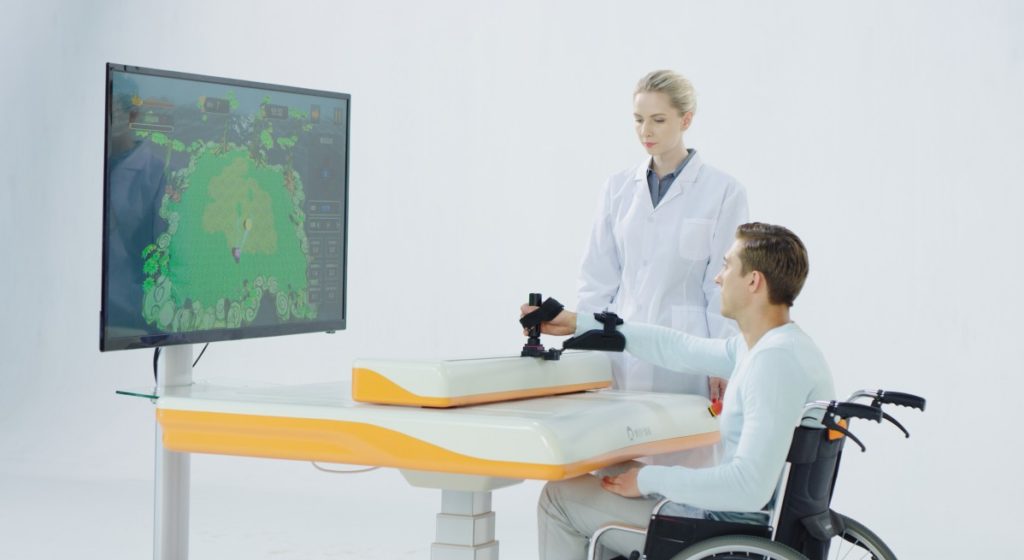Stroke Rehabilitation Technologies
Rebooting Recovery: The Revolution in Stroke Rehabilitation Powered by Robots, VR, and BCIs
One of the main causes of disability in the globe is stroke. It causes damage to brain cells and disturbances in blood flow to the brain, which can result in a variety of disabilities, including speech and motor issues. Thankfully, innovative new technologies are continually being developed in the field of stroke therapy to improve the healing process. Robotics, virtual reality (VR), and brain-computer interfaces (BCIs) are three examples of these technological breakthroughs that have specific advantages for stroke survivors.
Table of Contents

Robotic Support: Mirroring the Therapist’s Hands
Stroke Rehabilitation Technologies
Retraining motor abilities requires regulated, repetitive motions, which robotic rehabilitation systems offer. These gadgets can be divided into two primary groups:
- Exoskeletons: Wearable robots strapped to limbs are called exoskeletons. They provide powered support, helping with both active and passive movements. By modifying the degree of support, therapists can tailor therapy to the specific requirements of each patient.
- End-Effector Devices: These stationary apparatuses are designed to train particular joint or limb movements. They provide focused training for the upper and lower extremities by simulating natural movements and adjusting to the user’s development.
Among the advantages of robotics are:
Stroke Rehabilitation Technologies
- Increased Intensity and Repetition: Robots are able to deliver high-intensity therapy sessions on a regular basis, which is essential for neuroplasticity, the brain’s capacity to heal itself after injury.
- Decreased Therapist Fatigue: By taking over some repetitive duties, robots allow therapists to concentrate on more intricate facets of therapy.
- Goal Data Collection: By tracking movement data using sensors built into robots, therapists can keep an eye on patients’ progress and adjust their treatment plans accordingly.
The difficulties in robotics
- Cost: Some patients may not be able to access robotic devices due to their high cost.
- Bulkiness: Patient compliance may be hampered by exoskeletons that are heavy and uncomfortable to wear.
- Restricted usage: Not all stroke-related disabilities can be effectively treated by robots, and their usage necessitates the expertise of qualified therapists.
Virtual Reality: Entering a Rehabilitative Universe
Stroke Rehabilitation Technologies
Rehabilitation activities became more engaging and game-like thanks to virtual reality technology. Patients can engage in activities such as virtual street strolling, item reaching, and movement-targeting games. VR has several advantages, such as:
- Enhanced Engagement: Patients are more motivated and engaged when using VR because of its immersive and interactive features, which improves adherence to treatment plans.
- Task-Specific Training: By simulating real-world tasks, virtual reality (VR) enables patients to practice life-saving skills in a secure setting.
- Sensory Feedback: To improve motor control and the sensation of movement, several VR systems include sensory feedback like as vibration or temperature changes.
VR’s drawbacks
Stroke Rehabilitation Technologies
- Cost: Much with robotics, VR equipment can be costly.
- Cyber Sickness: When wearing virtual reality headsets, some patients may feel queasy or lightheaded.
- Limited Availability: Not all healthcare facilities may have access to VR rehabilitation programs.
Computer-Brain Interfaces: Interpreting the Thought Process
Stroke Rehabilitation Technologies
BCI technology allows information to flow from the brain to external devices. Patients can engage with their rehabilitation environment directly through their thoughts thanks to Brain-Computer Interfaces (BCIs), which can interpret brain signals and control robotic limbs or virtual avatars. Among the advantages of BCIs are:
- Neuroplasticity Boost: Brain-Computer Interfaces (BCIs) have the potential to augment motor learning and foster neuroplasticity by means of direct brain engagement during rehabilitation.
- Surpassing Physical Restrictions: By reestablishing the connection between the brain and movement, BCIs provide rehabilitation possibilities to individuals who suffer from severe paralysis.
- Enhanced Motivation: For stroke patients, the capacity to direct their motions with thinking can be extremely inspiring.
BCI Challenges:
- Technological immaturity: BCI technology is still in its infancy, and more investigation is needed to determine its efficacy in stroke rehabilitation.
- Complexity of Calibration: Adjusting Brain-Computer Interfaces (BCIs) to specific brain patterns can take a lot of effort and expertise.
- Ethical Considerations: Careful thought needs to be given to the ethical ramifications of employing BCIs in rehabilitation, including privacy and user control.
Joining Forces: An Integrated Rehabilitation Future
Stroke Rehabilitation Technologies
There is no conflict between these three technologies. Scholars are currently investigating methods to integrate them for even more potent rehabilitation. For example, BCIs could be used to control VR environments, enabling patients to navigate virtual worlds with just their thoughts. Furthermore, BCIs and robotics could work together to provide supported motions more intuitive and natural control.
Stroke Rehabilitation Technologies
Stroke recovery has a promising future. The potential for robotics, virtual reality, and brain-computer interfaces (BCIs) to tailor treatment, enhance patient outcomes, and ultimately enable stroke survivors to reclaim their freedom and quality of life is enormous.


